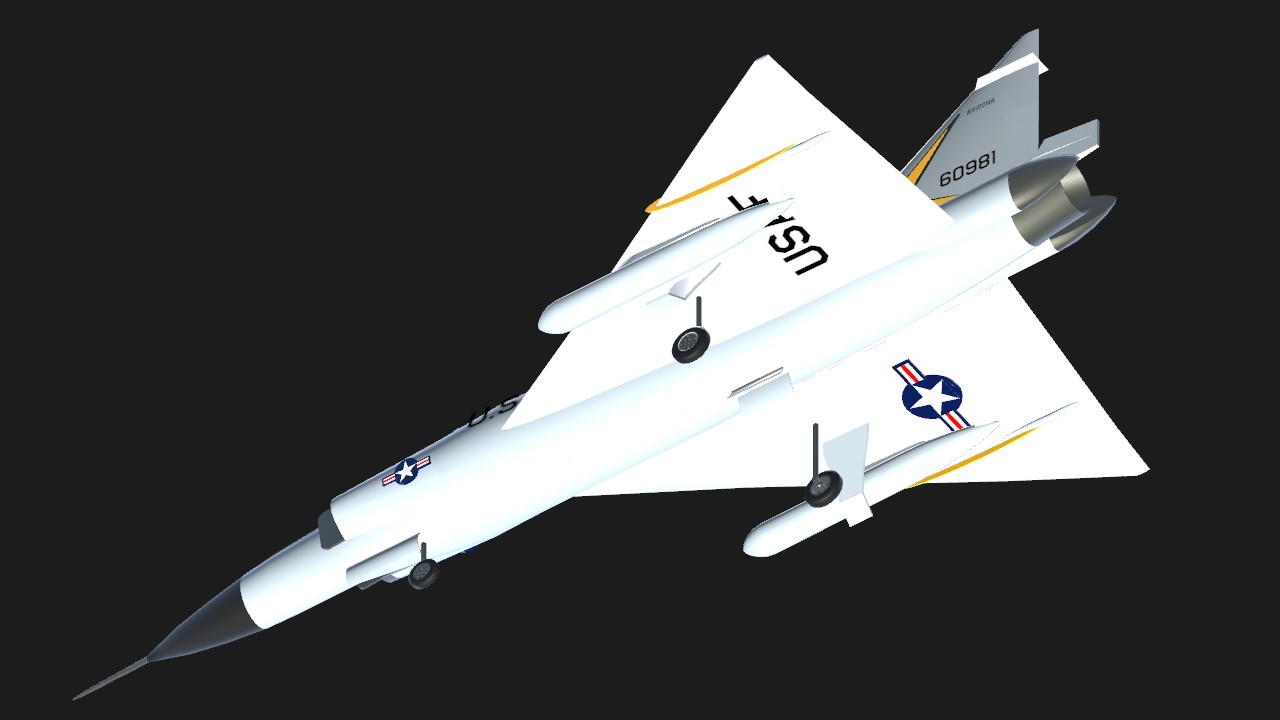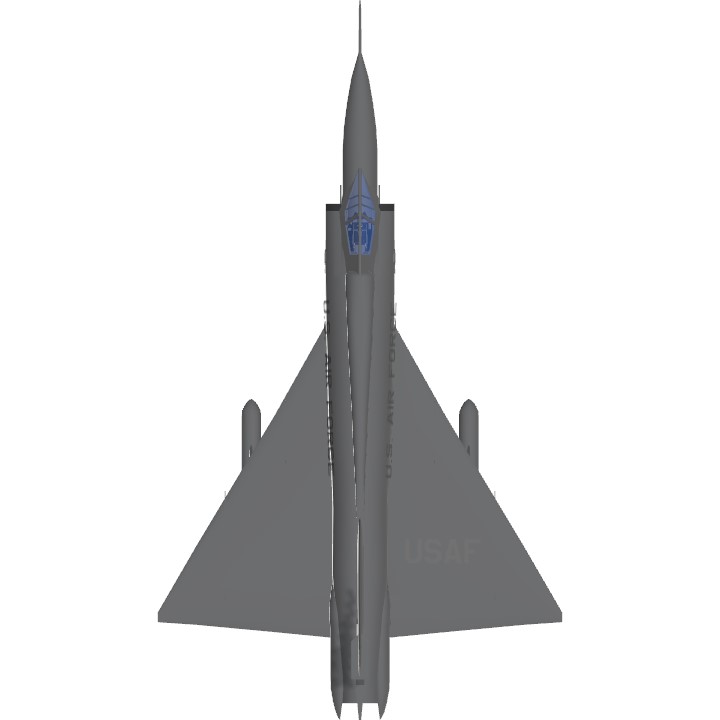The Convair F-102 Delta Dagger was a supersonic delta wing interceptor for the USAF during the Cold War.
Gallery:




Features:
- Armament: 3x GAR-1 Falcon, 3x GAR-2 Falcon, 2x 230 gallon drop tank
- Camouflage: ADC Gray
- Recreated with blueprints
- Fairly realistic performance
- A cockpit that should be VR compatible
Nonstandard Controls:
- AG 1 and Yaw: Nose Steering
- AG 2: Air Brake
- AG 3: Drogue Chute
- AG 4: Jettison Tanks
- AG 5: Weapons Bays Open/Close (allow a few seconds)
- Throttle>95% for Afterburner
- Trim for trim
Notes:
- Thanks @ChiChiWerx for the USAF roundels
- GAR 1: keep the target in the circle. GAR 2: fire and forget.
- Sorry about the occasional thudding sound during high-speed maneuvers but at this point I need to release this plane and move on to other projects :)
Background:
Beginning in 1948, the USAF initiated an ambitious program for a high-performance interceptor aircraft to enter service in 1954. Convair proposed a delta wing design based on their recent research with the XF-92 prototype. The Air Force was impressed, and it was selected as the winner of the competition. Unfortunately, development of two crucial components for the interceptor, the fire control system and the engine, was lagging behind. It was decided to press an interim aircraft into service with a less powerful engine and a less advanced fire control system. This aircraft was designated F-102 and named the Delta Dagger.
The prototype Delta Dagger first flew in 1953, and performance fell far short of the goals. With lower top speed, range, and altitude than expected, Conviar began a major redesign. Applying the newly-developed Whitcomb area rule, the fuselage was made noticeably narrower at the thickest part of the wing and other changes were made to the rear and canopy. These small changes resulted in a significant increase in performance, and the F-102 was finally able to reach the desired speed of Mach 1.2.
Nicknamed the “Deuce” from its designation, the aircraft was typical of interceptors of the day: visibility was poor and no gun was fitted. Armament consisted of three GAR-1 and three GAR-2 Falcon missiles, fired together to compensate for their poor accuracy. Notably, all of the missiles were carried inside three internal weapons bays to reduce drag. Initially, 24 rockets were carried inside the doors of the weapons bays, to be fired at a bomber should the missiles fail to connect. But these proved maintenance intensive, and later in the Deuce’s career, were not carried.
The F-102 served in Vietnam, initially as a bomber escort. No air-to-air kills were scored. Later in the war, the Deuce was used for the ground-attack role. Pilots carried out strafing runs with the unguided rockets in the weapons bay doors, and even occasionally fired Falcon missiles at whatever heat sources or radar returns they could find on the ground. The plane and pilots were not meant for this role, however. Around a dozen F-102s were lost to all causes in the war, including one by a MiG-21. The F-102 was also used by Greece and Turkey throughout the 1970s.
The F-102 Delta Dagger left frontline interceptor service with the USAF in the first half of the 1970s. Though often overshadowed by its more advanced derivative, the F-106 Delta Dart, the Deuce was an important aircraft. It was the first delta wing plane in service with the USAF, their first supersonic interceptor, and one of the very first aircraft to use the area rule. Many of the 1000 built were destroyed as QF-102 target drones, but a number still survive in museums today.
Specifications
Spotlights
- This craft is curated
- ChiChiWerx 3.3 years ago
- NatsukiHoshino 3.3 years ago
- RicardoACE 3.3 years ago
- LonelyAustrianUhlan 3.3 years ago
- Dragoranos 3.3 years ago
- AnomalyYeet 3.3 years ago
General Characteristics
- Successors 2 airplane(s) +198 bonus
- Created On Windows
- Wingspan 41.8ft (12.7m)
- Length 74.3ft (22.7m)
- Height 23.4ft (7.1m)
- Empty Weight 19,588lbs (8,885kg)
- Loaded Weight 29,956lbs (13,587kg)
Performance
- Power/Weight Ratio 0.956
- Wing Loading 38.6lbs/ft2 (188.6kg/m2)
- Wing Area 775.3ft2 (72.0m2)
- Drag Points 1411
Parts
- Number of Parts 465
- Control Surfaces 5
- Performance Cost 2,039







Nice build, fun to fly. I like that you used the symmetric wing and kept the performance numbers fairly close.
miraj no but but
miraj but no